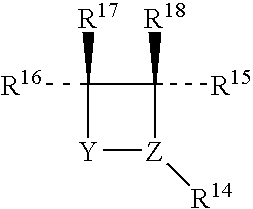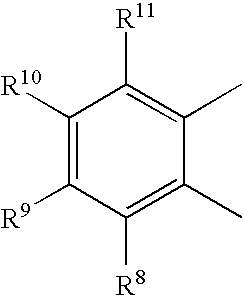Prodrugs activated by targeted catalytic proteins
a technology of catalytic proteins and prodrugs, applied in the field of prodrugs activated by targeted catalytic proteins, can solve the problems of reducing the potential efficacy, limiting the dose of pharmaceutical compounds that can be safely administered, and cytotoxic cancer chemotherapy agents generally have undesirable toxic effects on normal tissues, so as to reduce the risk of side effects, minimize systemic exposure, and increase the effect of therapeutic efficacy
- Summary
- Abstract
- Description
- Claims
- Application Information
AI Technical Summary
Benefits of technology
Problems solved by technology
Method used
Image
Examples
example 1b
Preparation of the Hapten of the Prodrug in Example 1a, the Linear Phosphonate of trimethoxybenzoate-5-fluorouridine, Compound 4
Refer to FIG. 1b for the bold numbered compounds in this Example.
Dibenzyl 3,4,5-trimethoxyphenylphosphate 2 can be prepared from the reaction of 3,4,5-trimethoxybromobenzene with dibenzyl phosphite at high temperature in the presence of tetrakis(triphenylphosphine)palladium (0), triethylamine and toluene following the procedure of J. Med. Chem. 32 (1989):1580-1590. Removal of the benzyl groups occurs on hydrogenation with 10% Pd on carbon to give the phosphonic acid 3. Subsequent reaction with 2',3'-isopropylidene-5-fluorouridine in the presence of BOPDC in pyridine, followed by acid hydrolysis with 50% formic acid at 65.degree. C. yields 5'-O-(3,4,5-trimethoxyphenylphosphonyl)-5-fluorouridine 4.
In detail, the synthesis is as follows:
Dibenzyl 3,4,5-trimethoxyphenyl phosphonate 2
3,4,5-Trimethoxybromobenzene is prepared following the procedure of Tetrahedron ...
example 2a
Preparation of Experimental Prodrug, Intramolecular trimethoxybenzoate-5-fluorouridine, Compound 10
Refer to FIG. 2a for the bold numbered compounds in this Example.
The bromobenzoic acid 5, whose preparation is described in Example 12, undergoes lithium-halogen exchange and is alkylated with protected iodoethanol 7 (see FIG. 2a). The product 8 is dehydrated to form the symmetric anhydride, which is reacted with 5-fluorouridine to form a stable prodrug precursor, 9. The protecting group of the precursor can be removed rapidly to give the prodrug 10.
In detail, the synthesis is as follows:
2-Bromoethyl 4,4'-dimethoxytriphenylmethyl ether 6
DMAP (100 mmol) is added to a solution of 2-bromoethanol (100 mmol) and 4,4'-dimethoxytriphenylmethyl chloride (100 mmol) in DMF (100 mL) at room temperature. After 16 hours, the mixture is poured into water (300 mL) and extracted with ethyl acetate (3.times.100 mL). The organic phases are washed with water (100 mL), dried over anhydrous Na.sub.2 SO.sub...
example 2b
Preparation of the Hapten of Prodrug in Example 2a: The Cyclic Phosphonate of trimethoxybenzoate-5-fluorouridine, Compound 15
Refer to FIG. 2b for the bold numbered compounds in this Example.
The cyclic phosphonate 13 is synthesized following a typical strategy: bromination, lithiation, hydroxyalkylation, and cyclization of an aryl phosphonate 11. Saponification of the phosphonate ester, chlorination, and reaction with 2',3'-isopropylidene-5-fluorouridine followed by acid hydrolysis with 50% formic acid at 65.degree. C. gives the hapten 15.
In detail, the synthesis is as follows:
Diethyl 3,4,5-trimethoxyphenylphosphonate 11
Diethyl 2-bromo-3,4,5-trimethoxyphenylphosphonate 12
A solution of bromine (10 mmol) in 10 mL of acetic acid is added dropwise to a solution of ester 11 (10 mmol) in 10 mL of acetic acid cooled by an ice water bath. After the red color of the resulting mixture is discharged, the mixture is poured into saturated NaHCO.sub.3 (100 mL) and extracted with ethyl acetate (3.t...
PUM
| Property | Measurement | Unit |
|---|---|---|
| Fraction | aaaaa | aaaaa |
| Time | aaaaa | aaaaa |
| Fraction | aaaaa | aaaaa |
Abstract
Description
Claims
Application Information
 Login to View More
Login to View More - R&D
- Intellectual Property
- Life Sciences
- Materials
- Tech Scout
- Unparalleled Data Quality
- Higher Quality Content
- 60% Fewer Hallucinations
Browse by: Latest US Patents, China's latest patents, Technical Efficacy Thesaurus, Application Domain, Technology Topic, Popular Technical Reports.
© 2025 PatSnap. All rights reserved.Legal|Privacy policy|Modern Slavery Act Transparency Statement|Sitemap|About US| Contact US: help@patsnap.com



